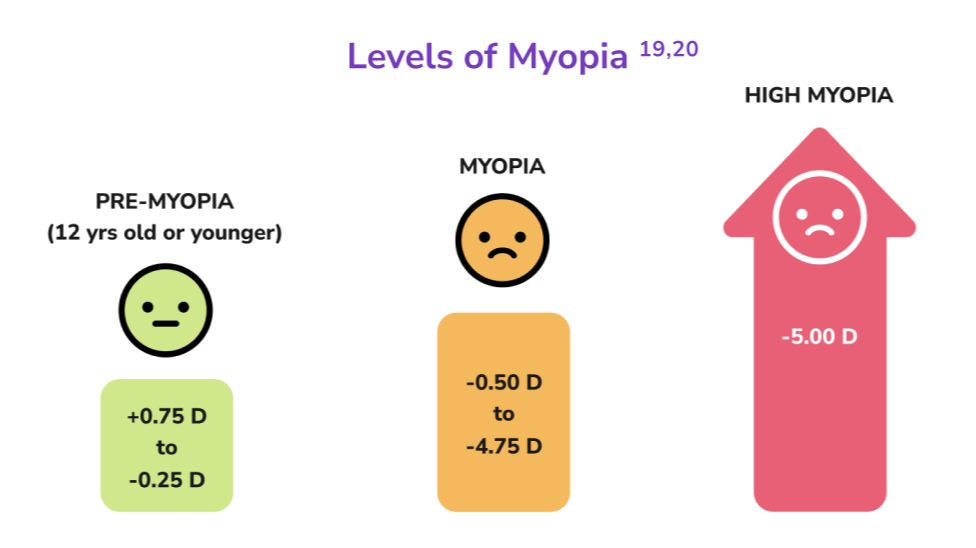Understanding Myopia

What is Myopia?
Myopia is more than nearsightedness or the inability to see distant objects clearly.1 So what is the definition of myopia?
Here are four key facts to know:
- Myopia is a chronic, progressive disease that leads to the eye growing too long.1-3
- This lengthening of the eye changes the eye’s ability to focus on distant objects, resulting in blurry vision.1
- Myopia may also increase the risk of permanent vision loss due to the development of cataracts, glaucoma, retinal detachment, myopic macular degeneration, or other eye conditions.4
- Lifestyle changes, including more near work (focusing on digital screens, books, and other up-close objects) and less outdoor time, are contributing to more children than ever before developing myopia at an early age.5,6
Myopia in Children is a Growing Problem
Previously, myopia was thought of as simply nearsightedness or blurry distance vision.1 We now know it’s so much more. Myopia is a chronic, progressive disease that is affecting children at an alarming pace.1-3 The number of people with myopia has nearly doubled over the past 20 years.7 It’s estimated that more than 80% of children in Singapore have myopia.8
Every Change in Eyesight Matters

While high levels of myopia tend to increase the risk of sight threatening complications later in adulthood, there is no safe level of myopia.1
Even lower levels of myopia can be associated with an increased risk of eye issues.1 Every diopter (for example, a change in prescription from -2D to -3D) increase in myopia raises the risk of myopic macular degeneration, a sight threatening eye disease, by 67%.10
What Can I Do About My Child’s Myopia?
Once a child develops myopia, it s very likely to worsen as they grow, resulting in the need for higher and higher prescriptions for glasses or contact lenses.10
- Every child should be monitored for myopia from an early age, with annual comprehensive eye exams starting by the age of 5. 11,12
- A comprehensive eye exam which is much more extensive than an annual vision screening at school can detect the early signs of myopia, as well as more than 270 systemic and chronic diseases.13
- There are treatments available that can help control the progression of your child's myopia like Abiliti® contact lenses.
Making Adjustments to Your Child’s Routine
More time outdoors
Research shows that spending at least two hours per day outdoors can help reduce myopia onset or control its progression.15
Less near work
The 20-20-20 rule
References:
1. Flitcroft DI. The complex interactions of retinal, optical and environmental factors in myopia aetiology. Progress in Retinal and Eye Research. 2012 31(6):622-660.
2. Donovan L, Sankaridurg P, Ho A, et al. Myopia progression rates in urban children wearing single-vision spectacles. Optom Vis Sci. 2012;89(1):27-32.
3. Pärssinen O, Kauppinen M. Risk factors for high myopia: a 22-year follow-up study from childhood to adulthood. Acta Ophthalmologica. 2019;97(5):510-518.
4. Haarman AEG, Enthoven CA, Tideman JWL, et al. The Complications of Myopia: A Review and Meta-Analysis. Invest Ophthalmol Vis Sci. 2020 Apr 9;61(4):49.
5. Huang HM, Chang DS, Wu PC. The Association between Near Work Activities and Myopia in Children-A Systematic Review and Meta-Analysis. PLoS One. 2015 Oct 20;10(10):e0140419.
6. Wu PC, Chen CT, Chang LC, Niu YZ, Chen ML, Liao LL, Rose K, Morgan IG. Increased Time Outdoors Is Followed by Reversal of the Long-Term Trend to Reduced Visual Acuity in Taiwan Primary School Students. Ophthalmol. 2020 Nov;127(11):1462-1469. doi: 10.1016/j.ophtha.2020.01.054.
7. Holden BA, Fricke TR, Wilson DA, et al. Global Prevalence of Myopia and High Myopia and Temporal Trends from 2000 through 2050. Ophthalmology 2016;123:1036-42.
8. Koh V, Yang A, Saw SM, et al. Differences in prevalence of refractive errors in young Asian males in Singapore between 1996-1997 and 2009-2010. Ophthalmic Epidemiol. 2014;21(4):247-255. doi:10.3109/09286586.2014.928824
9. Theophanous C, Modjtahedi BS, Batech M, Marlin DS, Luong TQ, Fong DS. Myopia prevalence and risk factors in children. Clin Ophthalmol. 2018;12:1581-1587.
10. Bullimore MA, Brennan NA. Myopia-control: Why Each Diopter Matters. Optom Vis Sci. 2019;96:463-5.
11. Mutti DO, Hayes JR, Mitchell Gl, et al. Refractive error, axial length, and relative peripheral refractive error before and after the onset of myopia. Invest Ophthalmol Vis Sci. 2007 Jun;48(6):2510-9.
12. Morgan IG, French AN, Ashby RS, Guo X, Ding X, He M, Rose KA. The epidemics of myopia: Aetiology and prevention. Prog Retin Eye Res. 2018 Jan;62:134-149.
13. American Optometric Association. Annual Comprehensive Eye Exam. American Optometric Association. Comprehensive Eye Exam. Available from: https://www.aoa.org/healthy-eyes/caring-for-your-eyes/eye-exams?sso=y
14. American Optometric Association. Systemic Conditions with Ocular and Visual Manifestations. December 2014.
15. Wu PC, Chen CT, Lin KK, et al. Myopia Prevention and Outdoor Light Intensity in a School-Based Cluster Randomized Trial. Ophthalmol. 2018;125:1239-50.
16. Huang PC, Hsiao YC, Tsai CY, Tsai DC, Chen CW, Hsu CC, Huang SC, Lin MH, Liou YM. Protective behaviours of near work and time outdoors in myopia prevalence and progression in myopic children: a 2-year prospective population study. Br J Ophthalmol. 2020 Jul;104(7):956-961.
17. Johnson & Johnson Vision. Schedule an Eye Exam: Tips to Prioritize Your Eyes At Home. https://www.jjvision.com/prioritizeyoureyes.
18. He M, Xiang F, Zeng Y, et al. Effect of time spent outdoors at school on the development of myopia among children in China a randomized clinical trial. JAMA. 2015;314(11):1142-1148.
19. Flitcroft DI, He M, Jonas JB, et al. IMI-Defining and Classifying Myopia: A Proposed Set of Standards for Clinical and Epidemiologic Studies. Invest Ophthalmol Vis Sci 2019;60:M20-30
20. Impact of increasing prevalence of myopia and high myopia: Report of the Joint World Health Organization – Brien Holden Vision Institute Global Scientific Meeting on Myopia, University of New South Wales, Sydney, Australia, 16–18 March 2015
SG2121

